Podcast: Play in new window | Download
Subscribe: Apple Podcasts | RSS
 Just a short bus ride from Mexico City, following the brown signs with one word – piramides – is the most visited archaeological site in all of Mexico. Our name for the place is Teotihuacán, which is the Hispanicization of the Aztec name for the place, Teotihuácan, which has been interpreted to mean “the place where the gods were born.” While being the most visited archaeological site in Mexico, not much is known about it. No one knows what the inhabitants of the city actually called the city as no formal writing system existed there. The common language used at Teotihuacán is unknown, along with the ethnicity of its rulers. No one knows exactly who built the city of for what purpose. Archaeologists and historians are unclear whether or not Teotihuacán was an empire, a city-state or just a religious and commercial center with little or no territorial ambitions. It was one of the largest population centers in all of Mesoamerica at the time and some historians say that at its height of population in the first centuries AD it was easily the 5th or 6th most populous city in the world with over 125,000 people living there. In spite of its grandeur and scope and impact on Mexico many centuries after its collapse, Teotihuacán today largely remains a huge mystery.
Just a short bus ride from Mexico City, following the brown signs with one word – piramides – is the most visited archaeological site in all of Mexico. Our name for the place is Teotihuacán, which is the Hispanicization of the Aztec name for the place, Teotihuácan, which has been interpreted to mean “the place where the gods were born.” While being the most visited archaeological site in Mexico, not much is known about it. No one knows what the inhabitants of the city actually called the city as no formal writing system existed there. The common language used at Teotihuacán is unknown, along with the ethnicity of its rulers. No one knows exactly who built the city of for what purpose. Archaeologists and historians are unclear whether or not Teotihuacán was an empire, a city-state or just a religious and commercial center with little or no territorial ambitions. It was one of the largest population centers in all of Mesoamerica at the time and some historians say that at its height of population in the first centuries AD it was easily the 5th or 6th most populous city in the world with over 125,000 people living there. In spite of its grandeur and scope and impact on Mexico many centuries after its collapse, Teotihuacán today largely remains a huge mystery.
 What do we know of this place? When the Spanish arrived here in the early 16th Century, squatters lived among the ruins. The Aztecs, who ruled the surrounding area at the time of the Spanish Conquest, did not build Teotihuacán. In fact, the Aztec Empire only came to prominence about a thousand years after the height of the city. The Aztecs thought the place holy and it was said that the gods and the sun itself came from there. Emperor Montezuma, it was said, would take regular pilgrimages from his capital of Tenochtitlán to Teotihuacán. While revered by the Aztecs, no Aztec knew anything about the city’s origins, who lived there or why the place even existed.
What do we know of this place? When the Spanish arrived here in the early 16th Century, squatters lived among the ruins. The Aztecs, who ruled the surrounding area at the time of the Spanish Conquest, did not build Teotihuacán. In fact, the Aztec Empire only came to prominence about a thousand years after the height of the city. The Aztecs thought the place holy and it was said that the gods and the sun itself came from there. Emperor Montezuma, it was said, would take regular pilgrimages from his capital of Tenochtitlán to Teotihuacán. While revered by the Aztecs, no Aztec knew anything about the city’s origins, who lived there or why the place even existed.
Before we talk about modern archaeological finds and scientific and non-scientific theories and speculation, let’s begin with a general overview of the site layout. Teotihuacán is located in the modern Mexican state of México just 25 miles north of  present-day Mexico City. The city was built on a north-south axis aligned to precisely 15.5° east of north. The city’s grid extended uniformly across a vast land area. At the city’s height, around 450 AD, the area included in Teotihuacán proper covered some 32 square miles. Dominating the core of the city is the Avenue of the Dead, or Calzada de los muertos in Spanish, which is over 130 feet wide at its thickest point and runs over 3 miles long. The name Avenue of the Dead is a direct translation of the Nahuatl word for the road, Miccoatli. The Aztecs named it that because they believed the platforms lining the road contained tombs. Besides the platforms, on the side of this great road we see some of the most impressive pieces of monumental architecture in the ancient world. Two massive pyramids, the Pyramid of the Sun and the Pyramid of the Moon, dominate the ceremonial heart of the city along with large palaces and temples. Besides the pyramids the more notable buildings include the Temple of the Feathered Serpent, the Court of the Columns and the Quetzal-Butterfly Palace. On the western side of the Avenue of the Dead, across from the Temple of the Feathered Serpent is what is called the Great Compound, which served as the city’s massive marketplace. Most of these structures are surprisingly well preserved. The signs leading to Teotihuacán say piramides for a good reason; the Pyramid of the Sun and the Pyramid of the Moon dominate the ancient city. The Pyramid of the Sun is the largest pyramid at the site and the third largest pyramid in the world behind the Great Pyramid at Giza in Egypt and the Great Pyramid of Cholula found just south of Teotihuacán. Please see Episode number 26 of Mexico Unexplained for more information on the Great Pyramid of Cholula. Teotihuacán’s largest pyramid measures 720 feet by 760 feet at its base and is 260 feet tall. It has a volume of 41.8 million cubic feet of stone, rubble and a conglomeration of other materials. This massive structure, just
present-day Mexico City. The city was built on a north-south axis aligned to precisely 15.5° east of north. The city’s grid extended uniformly across a vast land area. At the city’s height, around 450 AD, the area included in Teotihuacán proper covered some 32 square miles. Dominating the core of the city is the Avenue of the Dead, or Calzada de los muertos in Spanish, which is over 130 feet wide at its thickest point and runs over 3 miles long. The name Avenue of the Dead is a direct translation of the Nahuatl word for the road, Miccoatli. The Aztecs named it that because they believed the platforms lining the road contained tombs. Besides the platforms, on the side of this great road we see some of the most impressive pieces of monumental architecture in the ancient world. Two massive pyramids, the Pyramid of the Sun and the Pyramid of the Moon, dominate the ceremonial heart of the city along with large palaces and temples. Besides the pyramids the more notable buildings include the Temple of the Feathered Serpent, the Court of the Columns and the Quetzal-Butterfly Palace. On the western side of the Avenue of the Dead, across from the Temple of the Feathered Serpent is what is called the Great Compound, which served as the city’s massive marketplace. Most of these structures are surprisingly well preserved. The signs leading to Teotihuacán say piramides for a good reason; the Pyramid of the Sun and the Pyramid of the Moon dominate the ancient city. The Pyramid of the Sun is the largest pyramid at the site and the third largest pyramid in the world behind the Great Pyramid at Giza in Egypt and the Great Pyramid of Cholula found just south of Teotihuacán. Please see Episode number 26 of Mexico Unexplained for more information on the Great Pyramid of Cholula. Teotihuacán’s largest pyramid measures 720 feet by 760 feet at its base and is 260 feet tall. It has a volume of 41.8 million cubic feet of stone, rubble and a conglomeration of other materials. This massive structure, just  like the Great Pyramid at Giza in Egypt, once was covered in a bright white, smooth limestone facing. This structure was most likely slightly larger in the past than it is now, as quarrying and reconstruction efforts have reduced the size of the pyramid slightly. Outward from the ceremonial center were living quarters and workshops for the various commercial trades found throughout the city. Teotihuacán may represent the first place in the Americas where multi-level apartment-house dwellings were built. The city was divided into barrios where peoples of different areas of Mesoamerica lived, notably the Otomi, Zapotec, Maya, Nahua and Mixtec peoples. Many of the buildings were fashioned in what would later be termed the talud-tablero architectural style, in which an inwards-sloping external side of a structure called a talud is surmounted by a rectangular panel called a tablero and repeated. This style was adopted by other sites throughout Mesoamerica. Many intricate and colorful murals survive throughout the city and depict everything from mythological allegories to scenes from everyday life. Many of these paintings were done in the fresco style ala the Italian Renaissance and are regarded as some of the best in the ancient Americas. There were also many canals for irrigation to support farming and many of the living areas had their own small gardens for food. There is a surprising lack of any evidence for fortifications at Teotihuacán.
like the Great Pyramid at Giza in Egypt, once was covered in a bright white, smooth limestone facing. This structure was most likely slightly larger in the past than it is now, as quarrying and reconstruction efforts have reduced the size of the pyramid slightly. Outward from the ceremonial center were living quarters and workshops for the various commercial trades found throughout the city. Teotihuacán may represent the first place in the Americas where multi-level apartment-house dwellings were built. The city was divided into barrios where peoples of different areas of Mesoamerica lived, notably the Otomi, Zapotec, Maya, Nahua and Mixtec peoples. Many of the buildings were fashioned in what would later be termed the talud-tablero architectural style, in which an inwards-sloping external side of a structure called a talud is surmounted by a rectangular panel called a tablero and repeated. This style was adopted by other sites throughout Mesoamerica. Many intricate and colorful murals survive throughout the city and depict everything from mythological allegories to scenes from everyday life. Many of these paintings were done in the fresco style ala the Italian Renaissance and are regarded as some of the best in the ancient Americas. There were also many canals for irrigation to support farming and many of the living areas had their own small gardens for food. There is a surprising lack of any evidence for fortifications at Teotihuacán.
Occupation at the site of Teotihuacán began around 200 BC. During this time many small urban centers began to emerge in central Mexico. At the 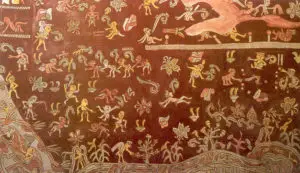 time of Teotihuacán’s ascendency another competing urban center in the southern part of the Valley of Mexico called Cuiculico was threatened by the eruption of the volcano Xitle. Scholars believe that the threat of the volcano caused people to emigrate from the southern shores of Lake Texcoco to the Teotihuacán Valley, thus encouraging the growth of the city. By 100 AD, the Pyramid of the Sun and most of the other massive buildings were completed. Building continued at a steady pace until 450 AD. Although the political structure of Teotihuacán is unknown, it is clear that a highly structured civil society was necessary to complete such organized and massive building projects. As found in graves and in the architecture of dwellings, there was definitely a hierarchy and a marked social order to the place. It’s long been debated whether or not Teotihuacán was the center of an empire, but we know of its influence both politically and culturally. Without a doubt, the city was the center of industry as hundreds of workshops employed craftsmen working in stone, clay, wood and feathers. Stamped
time of Teotihuacán’s ascendency another competing urban center in the southern part of the Valley of Mexico called Cuiculico was threatened by the eruption of the volcano Xitle. Scholars believe that the threat of the volcano caused people to emigrate from the southern shores of Lake Texcoco to the Teotihuacán Valley, thus encouraging the growth of the city. By 100 AD, the Pyramid of the Sun and most of the other massive buildings were completed. Building continued at a steady pace until 450 AD. Although the political structure of Teotihuacán is unknown, it is clear that a highly structured civil society was necessary to complete such organized and massive building projects. As found in graves and in the architecture of dwellings, there was definitely a hierarchy and a marked social order to the place. It’s long been debated whether or not Teotihuacán was the center of an empire, but we know of its influence both politically and culturally. Without a doubt, the city was the center of industry as hundreds of workshops employed craftsmen working in stone, clay, wood and feathers. Stamped 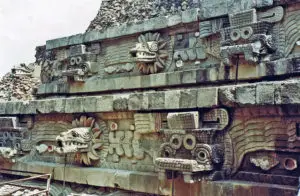 decorations found on Teotihuacán pottery is indicative of mass production. Fashioned obsidian and pottery from Teotihuacán has been found as far away as the Maya sites of Kaminalyjuyú in Guatemala and Copán in Honduras, almost a thousand miles away. To the north, the Teotihuacán trade network reached as far as the area of modern-day Santa Fe, New Mexico, with turquoise mined from the mountains around Cerillos found 1,400 miles away at Teotihuacán. There was definite contact between Teotihuacán and the ancient civilization of the Hohokam in Arizona, as the Mesoamerican ball game began to appear in the ancient cities around modern-day Phoenix around 500 AD. Some scholars believe that one of the major functions of Teotihuacán was religious. Archaeologists have discovered caves and tunnel structures underneath the pyramids in the city. These caverns may be related to the Mesoamerican creation myth and the center of the city may have been a place of pilgrimage, much as what had been witnessed in the latter days with the Aztecs visiting the ruins at Teotihuacán for religious reasons. Those scholars who propose Teotihuacán as a political empire that conquered or exacted tribute from surrounding areas much like the Aztecs, cite historical writings from the Maya, who had a written language at the time. The Maya called Teotihuacán Puh, or “The Place Where the Reeds Grow,” and references to the great city have been found at various Maya sites. An inscription found at the lowland Guatemalan Maya city of Tikal references a ruler called Jatz’om Kuh which has been translated as “Owl that will
decorations found on Teotihuacán pottery is indicative of mass production. Fashioned obsidian and pottery from Teotihuacán has been found as far away as the Maya sites of Kaminalyjuyú in Guatemala and Copán in Honduras, almost a thousand miles away. To the north, the Teotihuacán trade network reached as far as the area of modern-day Santa Fe, New Mexico, with turquoise mined from the mountains around Cerillos found 1,400 miles away at Teotihuacán. There was definite contact between Teotihuacán and the ancient civilization of the Hohokam in Arizona, as the Mesoamerican ball game began to appear in the ancient cities around modern-day Phoenix around 500 AD. Some scholars believe that one of the major functions of Teotihuacán was religious. Archaeologists have discovered caves and tunnel structures underneath the pyramids in the city. These caverns may be related to the Mesoamerican creation myth and the center of the city may have been a place of pilgrimage, much as what had been witnessed in the latter days with the Aztecs visiting the ruins at Teotihuacán for religious reasons. Those scholars who propose Teotihuacán as a political empire that conquered or exacted tribute from surrounding areas much like the Aztecs, cite historical writings from the Maya, who had a written language at the time. The Maya called Teotihuacán Puh, or “The Place Where the Reeds Grow,” and references to the great city have been found at various Maya sites. An inscription found at the lowland Guatemalan Maya city of Tikal references a ruler called Jatz’om Kuh which has been translated as “Owl that will 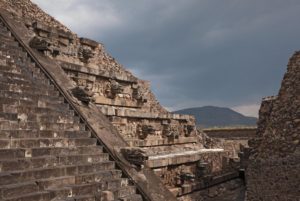 Strike” or “Spearthrower Owl”, a Teotihuacán ruler who reigned 60 years and died in the year 439 AD. Some say this king installed his relatives to rule over the Maya cities of Tikal and Uaxactun in modern-day Guatemala. A group of Mesoamerican scholars proposing an internalist view with regard to the relationship between Teotihuacán and the Maya world theorize that the ancient Maya only emulated the elites of Teotihuacán and were linked to that city through trade and copied elements of their culture and religion, but were politically separate from it. The externalist view believes that Teotihuacán militarily invaded the faraway cities of the Maya civilization and directly ruled over some of them. So, it is unclear whether or not Teotihuacán was the center of a political empire or merely the center of a commercial, cultural and/or ideological one.
Strike” or “Spearthrower Owl”, a Teotihuacán ruler who reigned 60 years and died in the year 439 AD. Some say this king installed his relatives to rule over the Maya cities of Tikal and Uaxactun in modern-day Guatemala. A group of Mesoamerican scholars proposing an internalist view with regard to the relationship between Teotihuacán and the Maya world theorize that the ancient Maya only emulated the elites of Teotihuacán and were linked to that city through trade and copied elements of their culture and religion, but were politically separate from it. The externalist view believes that Teotihuacán militarily invaded the faraway cities of the Maya civilization and directly ruled over some of them. So, it is unclear whether or not Teotihuacán was the center of a political empire or merely the center of a commercial, cultural and/or ideological one.
 Perhaps one of the biggest mysteries of this “Lost City of the Gods” is why it collapsed. There are many theories. These theories range from external warfare to environmental degradation to the “return of the star people” beliefs. The latest theory now in fashion is climate change, which is not surprising because many theories of collapses of ancient civilizations throughout the world tend to mirror our own contemporary ideas of doomsday. Many scientists believe that lengthy droughts occurring in the years 535 and 536 caused famine and pressure on the population and with that came social discord and the abandoning of the city. Smaller skeletons and remains showing malnutrition began to appear in the archaeological record at this time. In around the year 650 AD we know the city suffered a great fire, but the fire did not engulf the entire city. It was restricted to the ceremonial centers and the neighborhoods of the elites. This was accompanied by destruction of sacred objects and an overall looting of the wealthier areas of the city. 100 years after the fire Teotihuacán was a shadow of its former self.
Perhaps one of the biggest mysteries of this “Lost City of the Gods” is why it collapsed. There are many theories. These theories range from external warfare to environmental degradation to the “return of the star people” beliefs. The latest theory now in fashion is climate change, which is not surprising because many theories of collapses of ancient civilizations throughout the world tend to mirror our own contemporary ideas of doomsday. Many scientists believe that lengthy droughts occurring in the years 535 and 536 caused famine and pressure on the population and with that came social discord and the abandoning of the city. Smaller skeletons and remains showing malnutrition began to appear in the archaeological record at this time. In around the year 650 AD we know the city suffered a great fire, but the fire did not engulf the entire city. It was restricted to the ceremonial centers and the neighborhoods of the elites. This was accompanied by destruction of sacred objects and an overall looting of the wealthier areas of the city. 100 years after the fire Teotihuacán was a shadow of its former self.
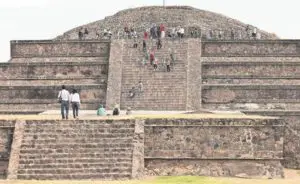 As an armchair archaeologist, I would like to put forth my own theory as to what caused the collapse of Teotihuacán. This theory has never been proposed by anyone else, as far as I know. As the producer of the podcast, I suppose I have a right to express myself beyond the general presentation of information, at least once in a while. My theory of the collapse of Teotihuacán may also be rooted in a somewhat contemporary vision of our own doomsday held by some. As Teotihuacán grew in size and wealth, we see it attracted more and more foreigners. A few centuries after the city’s founding, the impact of the foreigners was measurable. The barrios mentioned before that housed people from the Gulf Coast, the Maya regions of Central America and other far-flung parts of Mexico increased in size with time. We see this in the archaeological record with the increase in foreign pottery styles and religious iconography that
As an armchair archaeologist, I would like to put forth my own theory as to what caused the collapse of Teotihuacán. This theory has never been proposed by anyone else, as far as I know. As the producer of the podcast, I suppose I have a right to express myself beyond the general presentation of information, at least once in a while. My theory of the collapse of Teotihuacán may also be rooted in a somewhat contemporary vision of our own doomsday held by some. As Teotihuacán grew in size and wealth, we see it attracted more and more foreigners. A few centuries after the city’s founding, the impact of the foreigners was measurable. The barrios mentioned before that housed people from the Gulf Coast, the Maya regions of Central America and other far-flung parts of Mexico increased in size with time. We see this in the archaeological record with the increase in foreign pottery styles and religious iconography that 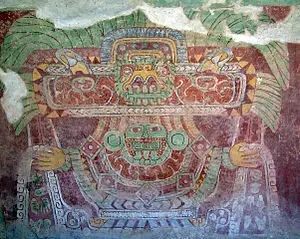 was coming from outside the traditions of the city. Did these foreign groups assimilate into the wider culture of Teotihuacán or did they butt heads with the rulers? According to the studies by Harvard professor Robert Putnam, increased cultural diversity in a limited geographical area causes increased strife. The mantra we hear in modern America, “diversity is our strength,” is called to question here. Back in Teotihuacán, it is quite curious that the Great Fire of 650 AD and its accompanied looting only raged through the elite areas of the city. This suggests great internal social turmoil. With foreigners outnumbering the native ruling classes, one could only imagine the tensions stemming from a variety of causes. I tend to think that the droughts that happened a century before the calamities of 650 AD had little effect on the collapse because, for one, the droughts were brief, and also, other cities in the area were on the rise while this one was on the decline. A drought would have affected the other major cities in the area, too, like Cholula, and it did not. Perhaps you can throw my theory of cultural diversity causing the collapse onto the pile of unfounded speculations and misdirected musings regarding the end of Teotihuacán. Perhaps with more reflection on our own current situation with regard to immigration in the West this may cause archeologists and political historians to formulate similar theories with regard to Teotihuacán. Until we come up with a concrete and indisputable reason or set of reasons for the collapse of this great city, it will remain one of the greatest mysteries of ancient Mexico.
was coming from outside the traditions of the city. Did these foreign groups assimilate into the wider culture of Teotihuacán or did they butt heads with the rulers? According to the studies by Harvard professor Robert Putnam, increased cultural diversity in a limited geographical area causes increased strife. The mantra we hear in modern America, “diversity is our strength,” is called to question here. Back in Teotihuacán, it is quite curious that the Great Fire of 650 AD and its accompanied looting only raged through the elite areas of the city. This suggests great internal social turmoil. With foreigners outnumbering the native ruling classes, one could only imagine the tensions stemming from a variety of causes. I tend to think that the droughts that happened a century before the calamities of 650 AD had little effect on the collapse because, for one, the droughts were brief, and also, other cities in the area were on the rise while this one was on the decline. A drought would have affected the other major cities in the area, too, like Cholula, and it did not. Perhaps you can throw my theory of cultural diversity causing the collapse onto the pile of unfounded speculations and misdirected musings regarding the end of Teotihuacán. Perhaps with more reflection on our own current situation with regard to immigration in the West this may cause archeologists and political historians to formulate similar theories with regard to Teotihuacán. Until we come up with a concrete and indisputable reason or set of reasons for the collapse of this great city, it will remain one of the greatest mysteries of ancient Mexico.
REFERENCES USED (This is not a formal bibliography)
The Aztecs, the Maya and their Predecessors by Muriel Porter Weaver
Ancient Mesoamerica by Richard E. Blanton, Stephen A. Kowalewski, Gary Feinman and Jill Appel
Various online sources

3 thoughts on “Teotihuacán, The Lost City of the Gods”
Wow. Wow. Wow. You\’re theory of cultural diversity causing the collapse of Teotihuacán is very interesting. Very plausible. While listening to this podcast I couldn\’t help but see the similarities between Teotihuacán and Montezuma\’s Castle near Camp Verde, AZ. Of course, Montezuma\’s Castle was tiny in comparisons, but the Sinagua just vanished from there also, with no one really knowing why. I always found that fascinating. Another fine installment of Mexico Unexplained, Robert. Thank you.
Thank you for always being such a thoughtful listener. I always appreciate your comments.
I have been studying pyramid structures for years and I can never satisfy myself with any possible answer. I have came to the conclusion that there must have been a race of people with great knowledge of construction and organisation better than our knowledge of today. How I can to this conclusion is we have very advanced computers that could give us the answers but they cannot produce the answers we are looking for.
I think that there is a body of people who had the knowledge which has not been discovered and the knowledge they had was more sophisticated than ours.
The cutting and shaping of stone has not been solved.
The movement of monolithic stones is another.
I think that most of the dates of events and the naming of them leads us to wrong theories. I find it is difficult to remember what year did something happen and that is with a computer.
If we could start again, I think we would need a more open mind when coming to dating and naming thing that we find.
I have a theory about the Brochs but again no answer can be found about who built the Brochs but I think that enough of forward looking people could get together could give more answers.